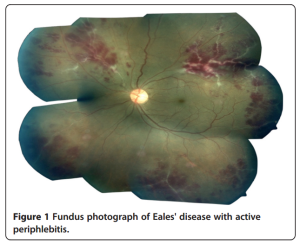Case report abstract
We present a case of a 48-year-old female with recurrent floaters and
decreased vision in her right eye. The onset of symptoms was in 2007 when a diagnose
of retinal vasculitis was made. She had no accompanying systemic signs and symptoms
and no history of ocular trauma or previous tuberculosis infection. The eye condition was
managed only with intermittent focal laser treatment, because the general treatment
with steroids was not efficient and poorly tolerated. After the laser treatment, the visual
acuity completely recovered and there was no recurrence of vitreous hemorrhage.
The case particularity was the unilaterality after 9 years from the onset.
Case report content
Original source: Romanian Journal of Ophtalmology – Volume 61 Issue 2 / 2017
Link to case study: https://rjo.ro/wp-content/uploads/2016/07/images_rjo_issue_2_2017_13.nicolcescu_andreea_final_PR.pdf

